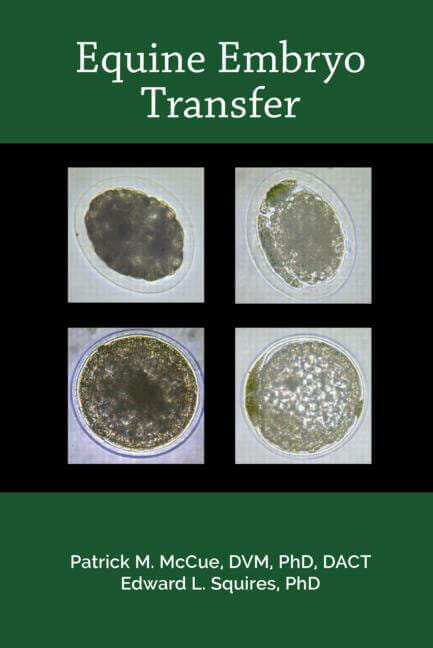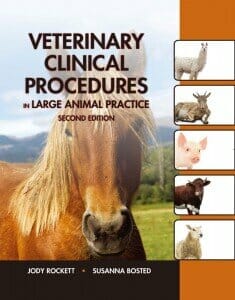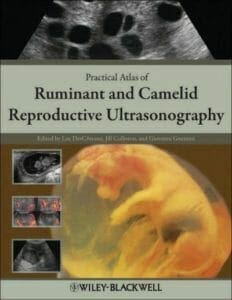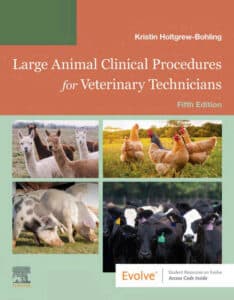Table of Contents
Contents
1. Introduction
General Introduction (i.e. what is ET)
Advantages and uses of embryo transfer
Changes in the ET Industry
Breed regulations (include a Table of most major breeds; ET, frozen embryos, etc.)
Per cycle ET Success = Embryo Collection Rate (50-60%) x Embryo Transfer Pregnancy Rate (70-80%)
Goals of the Manual
2. History of equine embryo transfer
Livestock
Horses
Domestic horses as surrogates for endangered equids(?)
3. Reproductive Anatomy and Physiology of the Mare
Anatomy of the mare
Physiology of the estrous cycle
Physiology of early embryonic development and early pregnancy
4. Management of the donor mare
Selection of the donor
Evaluation of the donor (BSE)
Management and Day of breeding (fresh, cooled, frozen semen)
Palpation/ultrasound examinations relative to flush; daily vs every 6-8 hrs for frozen semen; BID if goal is to collect a small embryo at day 6.5 for cryopreservation
Induction of ovulation (hCG and deslorelin)
Donor mare management (PMIE, fluid, etc.)
Estrous cycle control (Lights, P&E, PGF, hCG, Deslorelin, Regumate)
Allow a mare to carry to term by approximately 10 years of age
Allowing mare to carry own every 3-4 years
Effect of repeated flushing on uterine health and embryo recovery
# flushes per year recommended
Fertility of mares after flushing (i.e. same season)
Problem mares (i.e. PMIE, etc.)
Maiden mares (young vs older)
Post partum mares (i.e. flushing on foal heat)
5. Superovulation
History
Techniques
EFSH
Optimal follicle size at onset…
Problems – same stallion vs. goal of different stallions
Not every mare responds to FSH
PAF’s and HAF’s
6. Embryo Collection
Equipment (Box Table)
Facilities (stocks vs stall, etc.)
Procedure; (incl. clean out and wash up)
Ultrasound prior to flush in problem mares (PMIE) for fluid detection
Day of flush – options day 6.5, 7, 8, 9
Fluid volumes relative to maiden, open and post-foaling mares
Number of lavages per flush attempt
Rectal manipulation of uterus to move fluid around (massage)
Direct visualization of embryos in cup
Looking for embryos after each lavage
Techniques (Standard vs French, Fernando Rivera)
Medications (oxytocin, sedation, buscopan, etc.)
Reflush option (Extra flush same day standard; next-day reflush option; superovulation reflush (≥ 50 % embryo recovery relative to ovulation guideline)
PGF after flush; why (luteolysis – clean up and avoid unwanted carry-own pregnancy); what happens if you do not; option to let mare carry
7. Factors affecting embryo recovery
Donor age and reproductive status
Day of recovery
Number of flushes
Stallion effects
Number of ovulations (single vs. spontaneous multiple, superovulation)
Effect of ovulation rate and side of multiple ovulations on recovery rate (Fernando Riera data)
Synchronization of ovulations – embryo size and recovery
Reflushing (same day, next day)
8. Embryo Handling
Equipment – straws, dishes (size, round vs square)(Box Table)
Search procedures
Debris in dish (how to handle)
Miscellaneous items in dish
Swirling dish
Embryo size expected
Embryo morphology expected
Hints regarding bubbles, etc. (swirl, let contents settle, then aspirate bubbles along edge)
9. Washing and holding embryos
# and sizes of drops
Types of holding media; how long to hold a fresh embryo
Types of wash dishes (flat vs round bottom)
Storage vessels (dishes vs straws)
10. Evaluation of embryos
Morphology
Grade
Size
Lots of photographs and drawings
ET Log (flush and transfer logs)
11. Cooled Storage and Transport of Embryos
When to cool (i.e. how many hours between flush and transfer)
Cooled embryo technique
Time limit for holding embryos
Media available (types; buffer systems, etc) Ham’s F-10
Equipment
12. Cryopreservation of Embryos
History of embryo freezing
Slow freeze vs Vitrification
Selection of embryos (flush days, embryo size, etc.)
Vitrification technique (supplies, method)
Storage of vitrified embryos
Warming and transfer
Pregnancy results
13. Management of Recipient mares
What makes a good recipient
Selection – age, size, parity, temperament, physical health
History of mares (barren, maiden, foaling)
Examination schedule
Examination of recipients – 5 day check; pass system
Housing recipient mares
Synchronization options (new data from perla); general ‘window’ of synchrony (+1 to -3 or -4)
Line up recipient with embryo characteristics (fine tune)
Recipient:Donor Ration (3:1) for synchronization
Individual recipient for single donor (1:1) – how to manage
‘Floating’ recipient herd
Synchronization schemes
Optimal day(s) of transfer
Management after transfer (housing, hormones, etc.)
Use of non-cycling, ovariectomized, XO and pregnant mares as recipients
Using the donor mare as her own recipient (in the event of twin embryos)
14. Transfer Procedures
Surgery (midline, flank) [Old school] vs Nonsurgical/transcervical
Speculum procedure (Allen and Wilshire)
Equipment for nonsurgical (Box Table)
Day of transfer
Medications (pre and post)
Prostaglandin release during transcervical transfer (p4 Graph)
Technique – details
The ‘art of transfer’
15. Factors affecting pregnancy rates
Age and reproductive status of donor mare
Embryo age, quality and size
Transfer technique, technician variability
Recipient factors
Expected pregnancy rates (day 16 vs day 50 vs foaling)
Carry to term data (AQHA data)
Twins/Triplets from transfer of a single embryo
16. Pregnancy examination after transfer
Days of examination (11, 12, 14, 16, 25, etc)
Relationship between embryo size at transfer and first day visible on ultrasound (graph)
Percentage of truly pregnant recipients with embryos visible at 11, 12, 14, 16 days (graph)
17. Disease transmission with embryos
18. International transport of embryos
19. Miscellaneous
Embryo micromanipulation (splitting)
Embryo sexing
20. Future directions of equine embryo transfer
Superovulation
Early pregnancy factor – know when to flush
Improvement in reproductive management of problem mares (PGE oviduct)
Assisted reproduction
Embryo biopsy for genetic diagnosis
Appendix 1: ET Equipment and supplies
Sources
Catheters
Fluid types (LRS vs Complete vs old style PBS); osmolarity; pH; stability/shelf life; protein source (FCS, albumen vs PVA) to prevent embryos from sticking; ingredients (general); buffer systems (if any)
Y tubing
Filter cups – types (list and photos), how to use them (i.e. fill with fluid as per Fernando Rivera); direct visualization vs pour-off)
Search dishes (round vs square; size; gridded vs plain)
Microscopes and micrometer (types of scopes; magnification, glass – clear vs frosted; sources; new vs used)
Cleaning procedures (what can be re-used); autoclave; enzyme cleaning; gas sterilization)















![Ettinger’s Textbook of Veterinary Internal Medicine 9th Edition [PDF+Videos] Ettinger’s Textbook of Veterinary Internal Medicine 9th Edition [True PDF+Videos]](https://www.vet-ebooks.com/wp-content/uploads/2024/10/ettingers-textbook-of-veterinary-internal-medicine-9th-edition-100x70.jpg)

![Textbook of Veterinary Diagnostic Radiology 8th Edition [PDF+Videos+Quizzes] Thrall’s Textbook of Veterinary Diagnostic Radiology, 8th edition PDF](https://www.vet-ebooks.com/wp-content/uploads/2019/09/textbook-of-veterinary-diagnostic-radiology-8th-edition-100x70.jpg)






